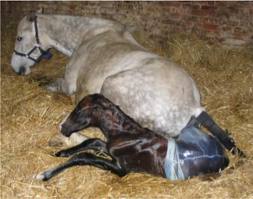|
Foaling Behavior
Foaling behavior traits associated with parturition (the birth process) are deeply rooted in the evolutionary development of horses. A basic assumption is that horses have evolved foaling behavioral strategies that ensure their survival. During the birth process, both the dam and her offspring are in a weakened state and are susceptible to attack by predators. The mare takes steps to increase their safety during parturition. In general, these steps include locating a safe site for foaling, quickening the process, minimizing evidence of the process, and achieving rapid recovery.
Pre-Parturient Mare Behavior Mares will generally foal after an 11-month gestation, but this is highly variable. Studies have shown a range of gestation from 315 to 387 days, with an average of about 341 days. There is evidence that smaller breeds tend to have shorter gestation periods. One study, for example, found ponies had a gestation of 336 days. The foaling date can be determined through a calendar estimate of gestation and by watching for physical signs of approaching gestation, such as distended udder, swelling of the vulva, waxing of the teats, and teat secretions. Behavioral changes in late gestation are generally minimal, and may not be observed until shortly before birth.
Foaling Behavior Mares prefer privacy at foaling time. If possible, mares will delay birth until human observers are not around. Mares generally foal at night. One study, for example, indicated that approximately 80 percent of foals were born between midnight and 6 a.m.
Parturition is divided into three stages
•labor
•expulsion of the fetus
•passage of afterbirth
In the first stage of foaling, mares become restless. They will not eat and they may pace or walk in circles, look back toward their flank, and switch their tails. Some mares lie down and stand up repeatedly. Some will not drink water. This restless foaling behavior is usually shorter for older mares. This is the longest stage of foaling and can last anywhere from 30 minutes to six hours. As labor progresses, mares may assume a straddling, crouching position and may urinate frequently. When the mare breaks her water or starts expelling fluid, the first stage of parturition is completed.

The second stage of parturition, expulsion of the fetus, or actual birth, is shorter in duration than the first stage. Shortly before the foal is born, the mare may sweat profusely, especially around the flanks. If she is disturbed, the mare may temporarily delay the birth process. This is why observers of the foaling process are cautioned to minimize interference during the birth process so it can proceed normally The mare may be standing or lying down as contractions begin, but she usually will lie on her side for the actual birth. The mare may get up with part of the foal exposed but will normally lie down to complete the birthing process, provided she is not disturbed by observers. The foal is usually born after 12 to 18 minutes of heavy labor. Maiden mares (mares foaling for the first time) are more likely to take about an hour to expel the fetus. Handlers should be ready to assist if it goes much longer than an hour. Mature mares in labor for more than 30 to 45 minutes may also need assistance.
The third stage is after the foal is born, the mare will continue to lie on her side for another 15 to 20 minutes. This time is important for the mare to rest and for blood flow from the placental tissues to pass into the colt. A mare who is disturbed during this period may rise prematurely and sever the umbilical cord. Therefore, handlers should avoid disturbing the mare for at least 15 minutes after a normal delivery. Handlers should also be aware that a normally gentle mare is likely to become nervous and protective during the first hours after giving birth. The mare may, in her protectiveness, become aggressive toward people.
Source - JT White, foaling behavior
Return from Foaling Behavior to Horse Riding Connection
|
